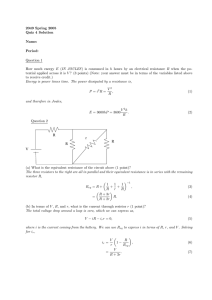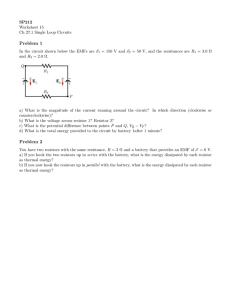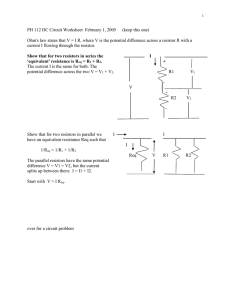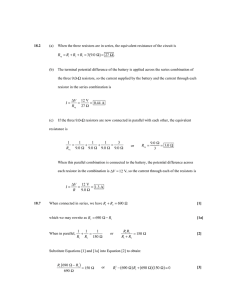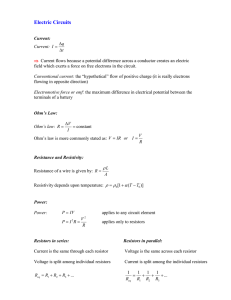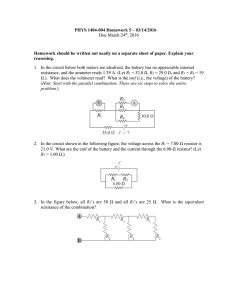pdf - MIT
advertisement
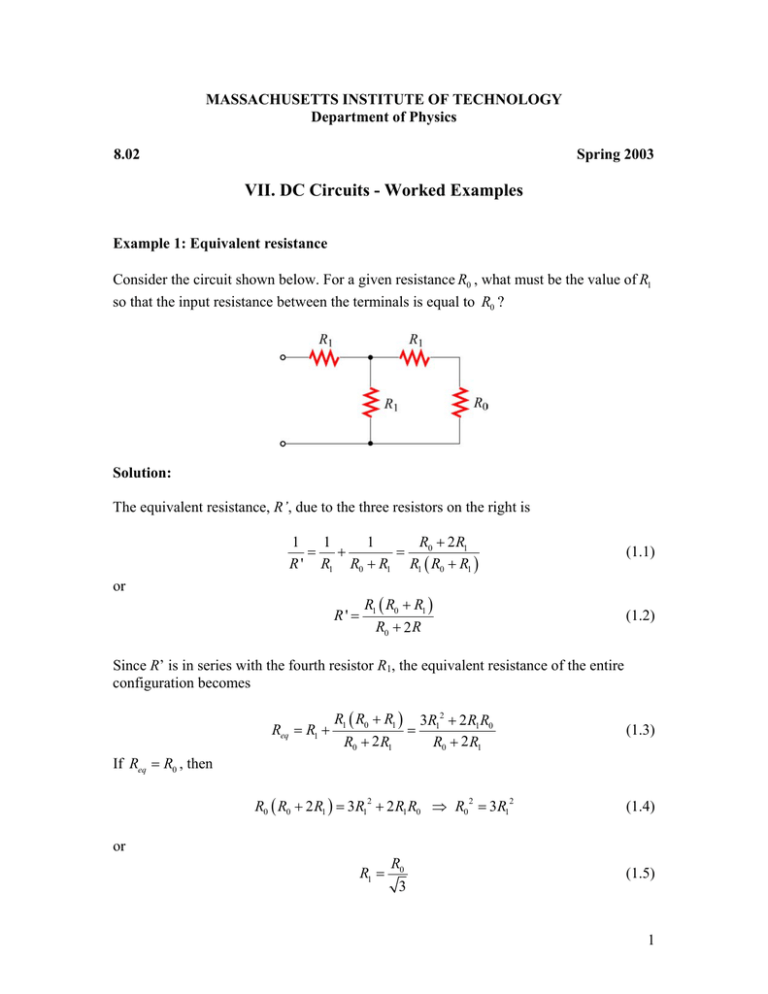
MASSACHUSETTS INSTITUTE OF TECHNOLOGY Department of Physics 8.02 Spring 2003 VII. DC Circuits - Worked Examples Example 1: Equivalent resistance Consider the circuit shown below. For a given resistance R0 , what must be the value of R1 so that the input resistance between the terminals is equal to R0 ? Solution: The equivalent resistance, R’, due to the three resistors on the right is R0 + 2 R1 1 1 1 = + = R ' R1 R0 + R1 R1 ( R0 + R1 ) or R' = R1 ( R0 + R1 ) R0 + 2 R (1.1) (1.2) Since R’ is in series with the fourth resistor R1, the equivalent resistance of the entire configuration becomes Req = R1 + R1 ( R0 + R1 ) 3R12 + 2 R1 R0 = R0 + 2 R1 R0 + 2 R1 (1.3) If Req = R0 , then R0 ( R0 + 2 R1 ) = 3R12 + 2 R1 R0 ⇒ R0 2 = 3R12 (1.4) or R1 = R0 3 (1.5) 1 Example 2: Variable resistance Show that, if a battery of fixed emf ε and internal resistance Ri is connected to a variable external resistance R , the maximum power is delivered to the external resistor when R = Ri Solution: Using Kirchhoff’s rule, ε = I ( R + Ri ) which implies I= (1.1) ε (1.2) R + Ri The power dissipated is equal to P = I 2R = ε2 ( R + Ri ) 2 R (1.3) To find the value of R which gives out the maximum power, we differentiate P with respect to R and set it to be 0: R −R dP 1 2R =ε2 − =ε2 i =0 2 2 3 dR ( R + Ri ) ( R + Ri ) ( R + Ri ) (1.4) R = Ri (1.5) which implies 2 Example 3: Multiloop Circuit Find the currents I1, I2 and I3 in the circuit below. Solution: Since there are three unknowns in the system, we need three linearly independent equations to find the solutions. Applying Kirchhoff’s current rule to junction c yields I1 + I 2 = I 3 (2.1) The other two equations can be obtained by using the voltage rule, which states that the net potential difference across all elements in a closed circuit loop is zero. Traversing the loops befcb and abcda clockwise leads to −ε 2 − I 2 R2 − ε1 + I1 R1 = 0 (2.2) ε 2 − I1 R1 − I 3 R3 = 0 (2.3) and One may also consider loop abefcda, which gives − I 2 R2 − ε1 − I 3 R3 = 0 (2.4) However, the above equation is not linearly independent since it is simply the sum of the previous two. The solutions to the above three equations are given by 3 I1 = ε1 R3 + ε 2 R3 + ε 2 R2 R1 R2 + R1 R3 + R2 R3 I2 = − I3 = ε1 R1 + ε1 R3 + ε 2 R3 R1 R2 + R1 R3 + R2 R3 (2.5) ε 2 R2 − ε1 R1 R1 R2 + R1 R3 + R2 R3 From the above expression, we see that I2 is a negative quantity. This simply implies that the direction of I2 is opposite of what we have initially assumed. Example 4: RC circuit In the circuit below, suppose the switch has been open for a very long time. At t = 0, it is suddenly closed. (a) What is the time constant before the switch is closed? (b) What is the time constant after the switch is closed? (c) Find the current through S as a function of time after the switch is closed. Solution: (a) Before the switch is closed, the two resistors R1 and R2 are in series with the capacitor. Since the equivalent resistance is Req = R1 + R2 , the time constant is given by τ = Req C = ( R1 + R2 )C (3.1) The amount of charge stored in the capacitor is 4 q(t ) = Cε (1 − e −t /τ ) (3.2) (b) After the switch is closed, the closed loop on the right becomes a decaying RC circuit with time constant τ ' = R2C . Charge begins to decay according to q '(t ) = Cε e −t /τ ' (3.3) (c) The current passing through S consists of two sources: the steady current I1 from the left circuit, and the decaying current I2 from the RC circuit. The currents are given by I1 = ε R1 ε dq ' Cε − t / τ ' =− = − e − t / R2C I '(t ) = e τ' dt R2 (3.4) The negative sign in I’(t) indicates that the direction of flow is opposite of the charging process. Thus, since both I1 and I’ move downward across the switch S, the total current is I (t ) = I1 + I '(t ) = ε + e − t / R2C R1 R2 ε (3.5) Example 5: Parallel vs. series connections The figures below show two resistors with resistance R1 and R2 connected in parallel and in series. The battery has a terminal voltage of ε. Suppose R1 and R2 are connected in parallel. (a) Find the power delivered to each resistor. 5 (b) Show that the sum of the power used by each resistor is equal to the power supplied by the battery. Suppose R1 and R2 are now connected in series. (c) Find the power delivered to each resistor. (d) Show that the sum of the power used by each resistor is equal to the power supplied by the battery. (e) Which configuration, parallel or series, uses more power? Solution: (a) When two resistors are connected in parallel, the current through each resistor is I1 = ε R1 I2 = , ε (4.1) R2 And the power delivered to each resistor is given by P1 = I12 R1 = ε2 R1 , P2 = I 22 R2 = ε2 R2 (4.2) The results indicate that the smaller the resistance, the greater the amount of power delivered If the loads are the light bulbs, then the one with smaller resistance will be brighter since more power is delivered to it. (b) The total power delivered to the two resistors is PR = P1 + P2 = ε2 R1 + ε2 R2 = ε2 Req (4.3) where 1 1 1 = + Req R1 R2 → Req = R1 R2 R1 + R2 (4.4) is the equivalent resistance of the circuit. On the other hand, the total power supplied by the battery is Pε = I ε , where I = I1 + I 2 , as seen from the figure. Thus, ε ε ε2 ε2 ε2 Pε = I1ε + I 2ε = ε + ε = + = = PR R1 R2 Req R1 R2 (4.5) 6 as required by energy conservation. (c) When the two resistors are connected in series, the equivalent resistance becomes R 'eq = R1 + R2 (4.6) and the currents through the resistors are I1 = I 2 = I = ε (4.7) R1 + R2 Therefore, the power delivered to each resistor is 2 2 ε P1 = I R1 = R1 , R1 + R2 ε P2 = I R2 = R2 R1 + R2 2 1 2 2 (4.8) Contrary to what we have seen in the parallel case, when connected in series, the greater the resistance, the greater the amount of power delivered. Once again, if the loads are light bulbs, the one with greater resistance will be brighter. (d) The total power delivered to the resistors is 2 2 ε ε ε2 ε2 PR = P1 + P2 = R R + = = 1 2 R1 + R2 R 'eq R1 + R2 R1 + R2 ' (4.9) On the other hand, the power supplied by the battery is ε ε2 ε2 Pε = I ε = = ε = R1 + R2 R 'eq R1 + R2 ' (4.10) Again, we see that Pε' = PR' , as required by energy conservation. (e) Comparing the results obtained in (b) and (d), we see that Pε = ε2 R1 + ε2 R2 > ε2 R1 + R2 = Pε' (4.11) which means that the parallel connection uses more power. The equivalent resistance of two resistors connected in parallel is always smaller than that connected in series. 7 Example 6: Resistor network Consider a cube which has identical resistors with resistance R along each edge, as shown in the figure below. Show that the equivalent resistance between points a and b is 5 R / 6 . Solution: From symmetry argument, the current which enters a must split evenly, with I / 3 going to each branch. At the next junction, say c, I / 3 must further split evenly with I / 6 going through the two paths ce and cd. The current going through the resistor in db is the sum of the currents from fd and cd : I / 6 + I / 6 = I / 3 . Thus, the potential difference between a and b can be obtained as Vab = Vac + Vcd + Vdb = I I I 5 R + R + R = IR 3 6 3 6 (5.1) which shows that the equivalent resistance is Req = 5 R 6 (5.2) 8


